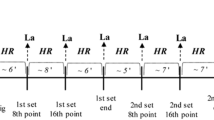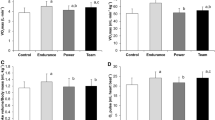Abstract
Although plyometrics are widely used in athletic conditioning, the acute cardiovascular responses to plyometric exercise in female subjects have not been described. The purpose of this study was to assess the acute effects of plyometric exercise on cardiovascular responses, as well as blood lactate concentrations in female volleyball and handball players. Eight semiprofessional volleyball plays and ten handball players volunteered to participate in this study. Subjects performed five sets of box jumps and depth jumps with ten repetitions, respectively. After each set of exercises, blood pressure and heart rate were assessed. Blood lactate concentration was measured before and after exercise. Muscle soreness was also measured immediately before and immediately after plyometric exercise as well as 24, 48 and 72 h after plyometric exercise. No differences were found in any physiological indices between volleyball and handball players, except heart rate during box jump set 2 and the rate pressure product (RPP) during box jump sets 2 and 5 and depth jump set 1 (P > 0.05). Plyometric exercise increased heart rate, systolic and diastolic blood pressure, and RPP after each set of exercises (P < 0.05). Also, heart rate and RPP were higher during the depth jump exercise (P < 0.05). Plyometric exercise did not induce any significant changes in muscle soreness (P > 0.05). The blood lactate concentrations were significantly increased above resting levels (P < 0.05). These findings suggest that plyometric box and depth jumping can be used in an overall programme to properly prepare athletes for competition in events that require both aerobic and anaerobic metabolism components.
Similar content being viewed by others
References
Tofas T, Jumurtas AZ, Fatouros I et al (2008) Plyometric exercise increases serum indices of muscle damage and collagen breakdown. J Strength Cond Res 22:490–496 28
Chu DA (1998) Jumping into plyometric. Human Kinetics, Champaign, IL
Arazi H, Asadi A, Coetzee B (2011) Comparative effect of land and aquatic based plyometric training on the jumping ability and agility of young basketball players. South Afr J Res Sport Phys Educ Rec (in press)
Miller MG, Herniman TJ, Ricard MD et al (2006) The effects of a 6-week plyometric training program on agility. J Sport Sci Med 5:459–465
Turner AM, Owings M, Schwane JA (2003) Improvement in running economy after 6 weeks of plyometric training. J Strength Cond Res 17:60–67
Saunders PU, Telford RD, Pyne DB et al (2006) Short term plyometric training improves running economy in highly trained middle and long distance runners. J Strength Cond Res 20:947–954
Arazi H, Asadi A (2011) The effect of aquatic and land plyometric training on strength, sprint, and balance in young basketball players. J Hum Sport Exerc 6:101–111
Rimmer E, Sleveret G (2000) Effects of a plyometric intervention program on sprint performance. J Strength Cond Res 14:295–301
Prapavessis H, McNair PJ (1999) Effects of instruction in jumping technique and experience jumping on ground reaction forces. J Orthop Sports Phys Ther 29:353–356
Miyama M, Nosaka K (2004) Influence of surface on muscle damage and soreness induced by consecutive drop jumps. J Strength Cond Res 18:206–211
Jakeman JR, Byrne C, Eston R (2010) Lower limb compression garment improves recovery from exercise induces muscle damage in young, active females. Eur J Appl Physiol 109:1137–1144
Chatzinikolaou A, Fatouros IG, Gourgoulis V et al (2010) The course of changes in performance and inflammatory responses after acute plyometric exercise. J Strength Cond Res 24:1389–1398
Twist C, Eston RG (2007) The effect of muscle damage exercise on maximal intensity cycling and drop jump performance. J Exerc Sci Fitness 5:79–87
Spurrs RW, Murphy AJ, Watsford ML (2003) The effect of plyometric training on distance running performance. Eur J Appl Physiol 89:1–7
Brown AG, Ray MW, Abbey BM et al (2010) Oxygen consumption, heart rate, and blood lactate responses to an acute bout of plyometric depth jumps in college-aged men and women. J Strength Cond Res 24:2475–2482
Holcomb WR, Kleiner DM, Chu DA (1998) Plyometrics: considerations for safe and effective training. Strength Cond J 20:36–39
Mohebbi H, Rahmaninia F, Sheikholeslamivatani D, Faraji H (2010) Post-exercise responses in blood pressure, heart rate and rate pressure product in endurance and resistance exercise. Med Sport 63:209–219
Gearhart RF, Goss FL, Lagally KM et al (2001) Standardized scaling procedures for rating perceived exertion during resistance exercise. J Strength Cond Res 15:320–325
Chen Y, Chandler MP, DiCarlo SE (1995) Acute exercise attenuates cardiac autonomic regulation in hypertensive rats. Hypertension 26:676–683
Halliwill JR (2001) Mechanisms and clinical implications of post exercise hypotension in human. Exerc Sport Sci Rev 29:65–70
Pescatello LS, Franklin BA, Fagard R et al (2004) American College of Sports Medicine position stand. Exercise and hypertension. Med Sci Sports Exerc 36:533–553
Arazi H, Rahmaninia F, Hosseini K, Asadi A (2011) Resting hormonal and cardiovascular responses to short term creatine loading and resistance exercises. World Appl Sci J (in press)
Fardy PS (1981) Isometric exercise and the cardiovascular system. Phys Sports Med 9:43–56
Markovic G, Mikulic P (2010) Neuro-musculoskeletal and performance adaptations to lower-extremity plyometric training. Sports Med 40:859–895
Wilmore JH, Costill DL (1988) Training for sport and activity, 3rd edn. Brown, Dubuque, IA
Caruso JF, Coday MA, Monda JK et al (2010) Blood lactate and hormonal responses to prototype flywheel ergometer workouts. J Strength Cond Res 24:749–756
Ratamess NA, Kraemer WJ, Volek JS et al (2005) Androgen receptor content following heavy resistance exercise in men. J Steroid Biochem Mol Biol 93:35–42
Hetzler RK, Seip RL, Boutcher SH et al (1991) Effect of exercise modality on rating perceived exertion at various lactate concentrations. Med Sci Sports Exerc 23:88–93
Weltman A (1995) Blood lactate responses to exercise. Human Kinetics, Champaign, IL
Author information
Authors and Affiliations
Corresponding author
Rights and permissions
About this article
Cite this article
Arazi, H., Asadi, A., Nasehi, M. et al. Cardiovascular and blood lactate responses to acute plyometric exercise in female volleyball and handball players. Sport Sci Health 8, 23–29 (2012). https://doi.org/10.1007/s11332-012-0123-8
Received:
Accepted:
Published:
Issue Date:
DOI: https://doi.org/10.1007/s11332-012-0123-8




